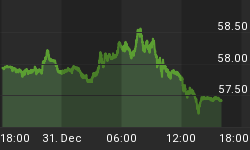Gold & Silver Trading Alert originally published on February 24th, 2014, 9:16 AM:
In short: In our opinion short positions (half): gold, silver, and mining stocks are justified from the risk/reward perspective.
Gold, silver and mining stocks didn't do much on Friday, so what we wrote in Friday's alert is generally up-to-date. However, since the week is over, we have weekly closing prices and volume levels. One of the ratios that we monitor provides a very significant indication as far as weekly price changes are concerned. Let's take a closer look (charts courtesy of http://stockcharts.com).

This is the juniors to stock market ratio - more precisely, the GDXJ ETF (proxy for the junior mining stock sector) to the SPY ETF (proxy for the S&P 500 Index) ratio.
What does this have to do with gold?
Much more than one might expect. Let's keep in mind the following about precious metals junior mining stocks and investors in general:
- Juniors are less likely to be held by institutional investors than individuals (mutual funds, for instance, often are allowed only to invest in big, senior companies, listed on major stock exchanges)
- Generally, individual investors tend to depend more on emotions than financial institutions do
- When the sentiment peaks, local tops are formed
Connecting the dots, we might expect juniors to perform particularly strongly right before local tops. Taking into account the fractal nature of the markets, we might also expect that this phenomenon to be present on a short- and long-term basis, but since large movements in sentiment are easier to detect from the long-term perspective, this type of analysis might be particularly useful in detecting more important tops.
Ok, but why divide juniors by other stocks?
Because that will allow to better focus on this sector's performance with regard to precious metals' price moves. In case there is a broad rally in the stock market, it could also lift mining stocks, including juniors, which could incorrectly make us draw conclusions about the precious metals sector. By dividing juniors by the stock market, we get the price of juniors without the impact of the general stock market. Technically, we get a ratio, but the above is a convenient way to think about it.
Moreover, the price is not the only thing that is divided. The above chart includes volume, but since a ratio is not traded by itself and doesn't have volume of its own, it's not a volume of ratio, but the ratio of volumes. Again, this will tell us when the volume in the junior sector was particularly significant but not because of huge volume across the board.
So, theoretically, if the juniors to stocks ratio rallies sharply then we might be looking at a local top. Does it work in practice?
There are no guarantees in any market, but it certainly looks this way. We included a 4-year chart and marked sharp rallies of the ratio - see for yourself. We put the ratio in the background (candlesticks) and we put the gold price (orange line) to make it easier for you to check the signals' performance. There are actually two different ways to approach the ratio and they both seem to work. One of them is the ratio itself and the second comes from the analysis of volumes.
Rectangles mark situations when the ratio moved much higher in a short period and then at least paused. It's easier to observe these phenomena using indicators: ROC (Rate of Change by definition should be very useful here) and Stochastic. We focused on the times when Stochastic was above the middle of its trading range (above 50) and in most cases, the ROC was above 10 as well. The only exception is the early 2012 top, which was included because the rallies in gold, ratio and indicators were clearly visible at that time.
Generally, all (7 out of 7) areas include either a relatively small or a significant decline. Prior to the 2011 top, the declines were local and after the 2011 top, the tops and following declines were major.
The second way to examine the chart is to look at times when volume increased on a relative basis. This is another way to detect increased interest in the juniors sector.
There were 4 cases in the past 4 years, which we marked with black ellipses. We didn't mark the areas when volume was gradually increasing - only times when it increased quickly. Again, in call cases declines or pullbacks followed shortly after the volume had increased.
What about the current situation? The volume first increased in January, and in the past 2 weeks it was simply huge. As far as the first approach is concerned, we have both indicators at their previous highs and the ROC indicator has already declined slightly. The Stochastic indicator hasn't flashed a sell signal yet, but if gold at least pauses or declines next week, we will likely see one and then the analogy to previous local tops based on the GDXJ:SPY ratio will be very strong. It's already strong but a sell signal from Stochastic could actually trigger a decline on its own in the current state of the market.
What does it all mean? Most importantly, it means that not all is as bullish in the precious metals sector as one might think. It seems that the recent rally caused investor sentiment to be too optimistic and this is likely to cause at least a correction.
To summarize:
Trading capital (our opinion): Short position (half): gold, silver, and mining stocks.
Stop-loss details:
- Gold: $1,346
- Silver: $22.36
- GDX ETF: $27.9
Long-term capital (our opinion): No positions.
Thank you.
As always, we'll keep our subscribers updated should our views on the market change. We will continue to send them our Gold & Silver Trading Alerts on each trading day and we will send additional ones whenever appropriate. If you'd like to receive them, please subscribe today.
















